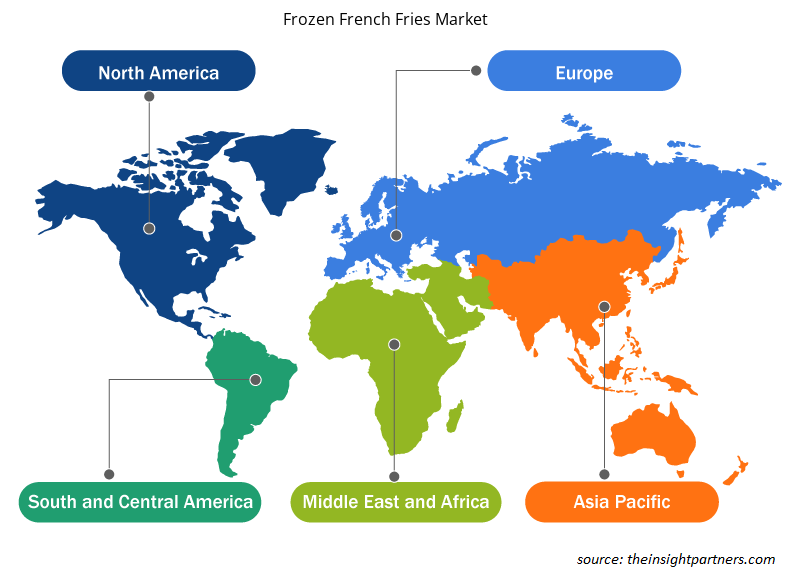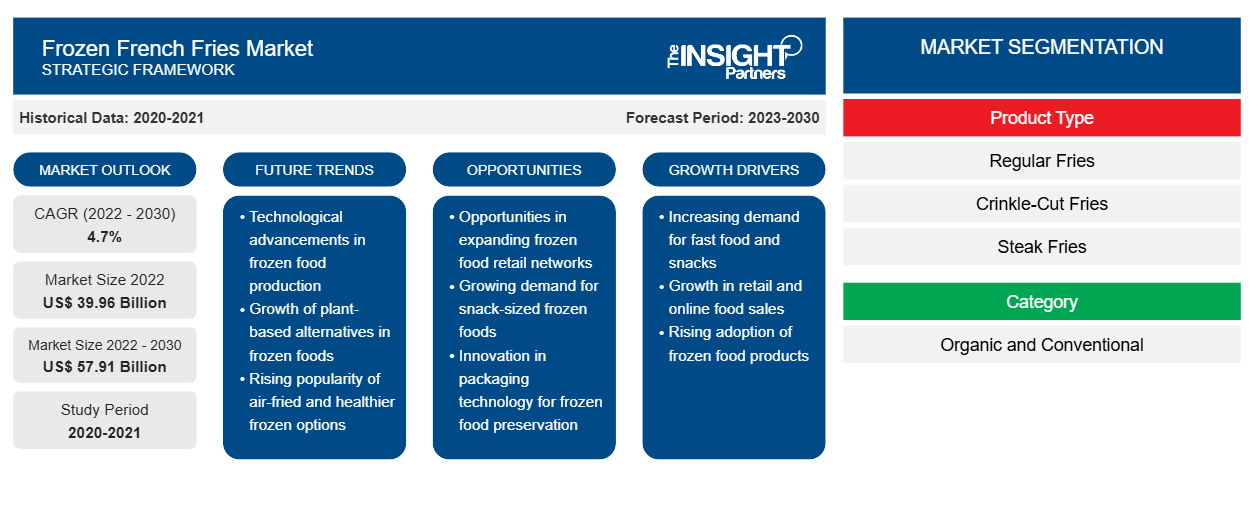[調査レポート] 冷凍フライドポテト市場は、2022年の399億5,511万米ドルから2030年には579億1,015万米ドルに成長すると予想されており、2022年から2030年にかけて4.7%のCAGRを記録すると予想されています。
市場洞察とアナリストの見解:
冷凍フライドポテトはジャガイモから作られ、温かい状態で提供されます。フライドポテトは、ワッフル、カーリー、細切りなど、さまざまな形で製造および提供され、便利なスナックとして食べられます。ケチャップ、サルサなどを添えて提供されます。フライドポテトは、焼いたり、揚げたりすることができます。さらに、新鮮で独特の調味料と香りがフライドポテトを競合他社から際立たせ、未知の料理体験を求める顧客を引き付けるのに役立ちます。フライドポテトの味のプロファイルは、さまざまなハーブ、スパイス、調味料ミックスを試すことで改善され、利用可能な選択肢が広がり、より幅広い消費者の選択を満たすことができます。世界的な冷凍フライドポテト市場の成長は、Food Panda、Swiggy、Uber Eatsなど、オンライン食品配達サービスを提供する企業数の増加に起因しています。これらの企業は、消費者にとって食品の注文を簡単で適切な作業にしました。さらに、主要な業界関係者による新製品の発売の増加により、予測期間中に冷凍フライドポテト市場が前進すると予想されます。
成長の原動力と課題:
コールドチェーンは、予冷、冷蔵保管、冷蔵輸送から成り、収穫後処理チェーンの柱の1つです。これは、あらゆる収穫後産業(先進国、発展途上国を問わず)の屋台骨であり、食品ロスの削減に不可欠な一連の技術とみなされています。コールドチェーン物流は、冷凍食品市場シェアの拡大を目指す国にとって極めて重要であることが証明されています。コールドチェーンのインフラは近年大幅に増加しています。たとえば、国際冷凍研究所(IIR)と世界コールドチェーンアライアンス(GCCA)のレポートによると、世界の冷蔵倉庫の総容量は2020年に7億1,900万立方メートルに増加し、2018年に報告された容量より16.7%増加しました。
さらに、新興国におけるコールドチェーンの能力拡大は国ごとに異なります。南アフリカ、メキシコ、ケニアなど、ほとんどの国では、コールドチェーンは都市部や、輸出業者が所在する空港などの輸送ターミナルに集中しています。さらに、主要な市場サービスプロバイダーは、競争で勝ち、世界中で効率、完全性、安全性を維持するために、常に技術の向上に努めています。たとえば、ベンダーは、小規模な出荷での効率を向上させるために、危害分析重要管理点(HACCP)と無線周波数識別(RFID)技術を実装しています。さらに、マルチコンパートメント冷蔵車両群を拡大して、消費者に追加サービスを提供しています。したがって、コールドチェーンインフラストラクチャの進歩は、冷凍フライドポテト市場のプレーヤーに有利な機会を提供し、冷凍フライドポテト市場の成長をさらに促進すると予想されます。
要件に合わせてレポートをカスタマイズする
このレポートの一部、国レベルの分析、Excelデータパックなど、あらゆるレポートを無料でカスタマイズできます。また、スタートアップや大学向けのお得なオファーや割引もご利用いただけます。
- このレポートの主要な市場動向を入手してください。この無料サンプルには、市場動向から見積もりや予測に至るまでのデータ分析が含まれます。
レポートのセグメンテーションと範囲:
「世界の冷凍フライドポテト市場」は、製品タイプ、カテゴリ、エンドユーザー、および地理に基づいてセグメント化されています。製品タイプに基づいて、市場は通常のフライドポテト、波型カットフライドポテト、ステーキフライ、その他に分類されます。カテゴリに基づいて、市場はオーガニックと従来型に分かれています。エンドユーザーに基づいて、冷凍フライドポテト市場は小売とフードサービスに分類されます。地理に基づく冷凍フライドポテト市場は、北米(米国、カナダ、メキシコ)、ヨーロッパ(ドイツ、フランス、イタリア、英国、ロシア、その他のヨーロッパ)、アジア太平洋(オーストラリア、中国、日本、インド、韓国、その他のアジア太平洋)、中東およびアフリカ(南アフリカ、サウジアラビア、UAE、その他の中東およびアフリカ)、南米および中米(ブラジル、アルゼンチン、その他の南米および中米)に分類されています。
セグメント分析:
製品タイプに基づいて、冷凍フライドポテト市場は、通常のフライドポテト、波型カットフライドポテト、ステーキフライドポテト、その他に分類されます。通常のフライドポテトセグメントは、2022年に冷凍フライドポテト市場で最大のシェアを占め、予測期間中に大幅な成長率を記録すると予想されています。冷凍フライドポテト市場における通常のフライドポテトは、ファーストフードレストラン、ハンバーガー店、家庭で人気のサイドディッシュです。通常のフライドポテトはステーキフライよりも薄く、通常1/8〜1/4インチの厚さにカットされています。塩味が付けられていることが多く、ケチャップ、酢、マヨネーズ、トマトソース、またはその他の地元の名物料理と一緒に提供されることがあります。
地域分析:
地理に基づいて、冷凍フライドポテト市場は、北米、ヨーロッパ、アジア太平洋、中南米、中東およびアフリカの5つの主要地域に分割されています。世界の冷凍フライドポテト市場は北米が主流で、2022年には約350億米ドルになると推定されています。ヨーロッパは2番目に大きな貢献者であり、市場の25%以上を占めています。北米の冷凍フライドポテト市場は、米国、カナダ、メキシコに分割されています。北米の冷凍フライドポテト市場は、米国、カナダ、メキシコに分割されています。この地域は、確立された食品加工産業と、テイクアウト、店内飲食、外出先での消費の増加傾向により、冷凍フライドポテトの主要市場の1つです。HJハインツ社、JRシンプロット社、マッケインフーズ社など、多くの主要な冷凍フライドポテトメーカーがこの地域で積極的に事業を展開しています。これらの企業は地域全体に事業を拡大し、大きな市場シェアを占めています。同社は地域内に広範囲にわたる流通ネットワークを持ち、多くの顧客のニーズに応えることができており、上記のすべての要因が冷凍フライドポテト市場の成長を促進しています。
業界の発展と将来の機会:
冷凍フライドポテト市場で活動している主要企業が行っているさまざまな取り組みを以下に示します。
- 2020年9月、Aviko BVは消費財大手ユニリーバからドイツのジャガイモ工場を買収した。この工場ではジャガイモを加工してマッシュポテト、餃子、ニョッキ、インスタントスナックなどのブランド製品を作っている。
- 2022年10月、ラムウェストンホールディングス社は、欧州合弁会社マイヤーフローズンフーズBVの残りの株式を7億6,358万米ドルで買収する契約を締結したと発表しました。
- 2021年7月、ラムウェストンは4億1,500万米ドルを投資してアイダホ州のフライドポテト工場をアップグレードしました。この加工ラインにより、アイダホ州のフライドポテト工場では年間3億5,000万ポンド以上の冷凍フライドポテトやその他のジャガイモ製品を生産できるようになります。
- 2023年3月、マッケインはコールデールへの多額の投資を発表し、アルバータ州コールデールの施設と生産量を2倍に拡大しました。この投資はマッケインの力強い事業成長を反映するものとなるでしょう。
冷凍フライドポテト市場の地域別分析
予測期間を通じて冷凍フライドポテト市場に影響を与える地域的な傾向と要因は、Insight Partners のアナリストによって徹底的に説明されています。このセクションでは、北米、ヨーロッパ、アジア太平洋、中東、アフリカ、南米、中米にわたる冷凍フライドポテト市場のセグメントと地理についても説明します。

- 冷凍フライドポテト市場の地域別データを入手
冷凍フライドポテト市場レポートの範囲
| レポート属性 | 詳細 |
|---|---|
| 2022年の市場規模 | 399.6億米ドル |
| 2030年までの市場規模 | 579.1億米ドル |
| 世界のCAGR(2022年 - 2030年) | 4.7% |
| 履歴データ | 2020-2021 |
| 予測期間 | 2023-2030 |
| 対象セグメント | 製品タイプ別
|
| 対象地域と国 | 北米
|
| 市場リーダーと主要企業プロフィール |
|
冷凍フライドポテト市場のプレーヤー密度:ビジネスダイナミクスへの影響を理解する
冷凍フライドポテト市場は、消費者の嗜好の変化、技術の進歩、製品の利点に対する認識の高まりなどの要因により、エンドユーザーの需要が高まり、急速に成長しています。需要が高まるにつれて、企業は提供品を拡大し、消費者のニーズを満たすために革新し、新たなトレンドを活用し、市場の成長をさらに促進しています。
市場プレーヤー密度とは、特定の市場または業界内で活動している企業または会社の分布を指します。これは、特定の市場スペースに、その規模または総市場価値と比較して、どれだけの競合相手 (市場プレーヤー) が存在するかを示します。
冷凍フライドポテト市場で事業を展開している主要企業は次のとおりです。
- バーツ・ポテト・カンパニー
- アビコBV
- アグリストNV。
- ラムウェストンホールディングス株式会社
- マケイン
免責事項:上記の企業は、特定の順序でランク付けされていません。

- 冷凍フライドポテト市場のトップキープレーヤーの概要を入手
COVID-19の影響:
COVID-19パンデミックは、さまざまな国の経済や産業に影響を及ぼしました。北米、ヨーロッパ、アジア太平洋(APAC)、中南米(SAM)、中東アフリカ(MEA)の主要国でのロックダウン、渡航禁止、事業停止は、食品・飲料業界を含むさまざまな業界の成長に悪影響を及ぼしました。製造ユニットの停止により、世界的なサプライチェーン、製造活動、配送スケジュール、さまざまな必需品および非必需品の販売が混乱しました。さまざまな企業が、2020年の製品配送の遅延や製品の今後の販売低迷の可能性を発表しました。さらに、ヨーロッパ、アジア、北米のさまざまな政府による海外旅行禁止により、企業はコラボレーションやパートナーシップの計画を一時的に保留せざるを得ませんでした。
競争環境と主要企業:
Bart's Potato Company、Aviko BV、Agristo NV、Lamb Weston Holdings Inc、McCain、Farm Frites International BV、Rairandev Golden Fries Pty Ltd、Himalaya Food International Ltd、JR Simplot Company、The Kraft Heinz Co は、世界の冷凍フライドポテト市場で事業を展開している有力企業です。これらの冷凍フライドポテト製造業者は、革新的な形状の最先端のスナック オプションを提供し、消費者に優れた体験を提供しています。
- 過去2年間の分析、基準年、CAGRによる予測(7年間)
- PEST分析とSWOT分析
- 市場規模価値/数量 - 世界、地域、国
- 業界と競争環境
- Excel データセット
最新レポート
関連レポート
お客様の声
購入理由
- 情報に基づいた意思決定
- 市場動向の理解
- 競合分析
- 顧客インサイト
- 市場予測
- リスク軽減
- 戦略計画
- 投資の正当性
- 新興市場の特定
- マーケティング戦略の強化
- 業務効率の向上
- 規制動向への対応





















 無料サンプルを入手 - 冷凍フライドポテト市場
無料サンプルを入手 - 冷凍フライドポテト市場